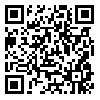BibTeX | RIS | EndNote | Medlars | ProCite | Reference Manager | RefWorks
Send citation to:
URL: http://sjsph.tums.ac.ir/article-1-281-en.html
Sulfur mustard is the most widely used chemical agent in the Iran-Iraq war .In a retrospective cohort study of 1337 soldiers with a history of sulfur mustard exposure, factors such as age, smoking habits, number of exposure episodes and the use of gas masks were determined, together with an assessment of their relationship with the occurrence of long-term pulmonary complications. The models suggested by Szklo,BresIow & Kahn were used to determine rates, rate ratios and confidence intervals. The mean age of the victims was 25.5 years (standard deviation = 9.1 years), and more than 96% had experienced only one exposure episode.
15.1% were cigarette smokers, and the majority (94.5%) had used protective gas masks at the time of exposure.
Cumulative incidence of lung complications was 31.6% the lowest rate was noted during the first year of follow-up (7.5/10000), and the highest in the 7th year (769/10000). Estimated rate ratios with 95% confidence intervals for various age groups were as follows: 1.12 (0.88-1.46) for those aged 21-25 years, 1.49 (1.1-2.01) for ages 26-30, 1.7 (1.2-2.4) forages 31-35, and 2.09 (1.55-2.77) for subjects aged 36 and above. Rate ratios with regard to other factors, i.e. more frequent versus single exposure, smoking vs non-smoking and unprotected exposure vs protective mask use were 0.69 (0.42-1.12), 1.08 (0.80-1.45) and 3.04 (2.20-4.20) respectively. Therefore, the estimated rale ratios were significant only for three out of four age groups and for those who had not worn gas masks (p<0.05). Therefore gas mask and age groups of veterans must be considered in assessing the potential consequences of a chemical attack.
| Rights and permissions | |
 |
This work is licensed under a Creative Commons Attribution-NonCommercial 4.0 International License. |





